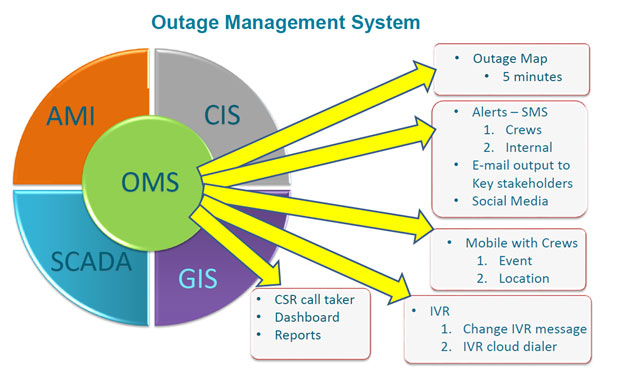Outage Management System
There is never a convenient time for an interruption in your electricity supply and often it happens at the worst time. Whether you’re watching the Oscars, helping your child with their homework or have a house full of guests waiting for a holiday dinner when the power goes out you need to know all about it.
The 4 questions that customers need to know as soon as the power goes out is:
- Where – does the utility know where the power outage has occurred?
- Why – does the utility know the cause?
- What – does the utility know how to fix it?
- When – does the utility know when it’s going to be restored?
Historically, when the outage occurs customers call into the utilities customer service centre and wait in the queue to be answered. When an available agent answer your call and you would be met with the standard response that crews have been dispatched and the power will be restored as soon as possible.M
Not really much to go on. It’s hard to plan around that response. Do you move your holiday dinner to someone else’s house or do you wait it out hoping the power comes back on quickly.
Improve customer efficiencies, responsiveness, and operational awareness.
Oshawa Power has now implemented an Outage Management System (OMS) utilizing existing technology that will improve its customer efficiencies, responsiveness, and operational awareness.
Oshawa Power is leveraging the power of social media to enhance its customer communications during outages, as well as managing day-to-day outages through automation.
The OMS centralizes all of the data from the GIS, CIS, AMI and SCADA currently collected and available and immediately communicates that information out to crews with predicted cause and customer service information platforms.

Canada’s only utility to dispatch directly from OMS
Oshawa Power is the only utility in Canada that will dispatch a crew directly from the OMS without the involvement of an operator. When the OMS receives the signal of an outage it will:
- dispatch a crew and provide exact location of the outage
- immediately post an information message on social media with pertaining details
- send a file to the telephone system to call out to the affected customers and inform them of the outage
- provide remote capabilities for the crews to update status of the outage on a tablet which in turn sends an update message to social media
So imagine now going back to our earlier scenario, you have a house full of guests waiting for their holiday dinner and the power goes out. You can now grab your smartphone, check social media and read about the power outage that just occurred.
You will immediately know that Oshawa Power knows:
- Where –the location
- Why – the predicted cause
- What – how to fix it
- When – approximately how long it will take to restore
While you’re checking your smartphone your phone rings and its Oshawa Power giving you the courtesy call informing you of the power outage.
The OMS can predict the outage before it occurs
Taking this one step further the OMS can predict outages as well. The OMS utilizes the utility’s existing technology and monitors system performance. When it recognizes that a potential outage can occur it dispatches the location to the crews for repair before the power goes out.
With this technology gone are the days of only having limited knowledge available to you of when the power will be restored. Now when we know about the outage, you know about the outage.


